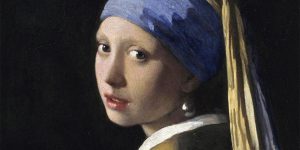Art is a varied expression of man’s creativity that can be appreciated by the sense of touch and sight. It sends the creator’s message with the purpose to draw an emotional attraction. There is always a story to tell about every piece of art: the appreciator’s interpretation about it in plain sight, the creator’s perception of the art’s purpose, the need to know the story behind it, and the message it entails.
Beautiful as it is, the mysteries and questions behind art make it more interesting. The technique used, the style applied, and the material leave unanswered questions about how the art piece came to be and makes it more valuable. In history, many stories were concocted to fill in the puzzle., some even involved theft. Often, people that possess the answers have taken the truth with them to the grave.
“The works must be conceived with fire in the soul but executed with clinical coolness.” — Joan Miro
 The Girl With The Pearl Earing
Advertisements
The Girl With The Pearl Earing
Advertisements

This painting of a girl with a pearl earring turning was done by Johannes Vermeer. People wonder whether the girl in the painting was Vermeer’s daughter or a lover. There is also the possibility of her not actually existing in reality.
Exhibited in the 17th century, this was a ‘tronie,’ a study of face and shoulders with a big and unusual costume. Tracy Chevalier, the author of a popular novel about the painting, said that the painting works because of its unsolved mystery.
 The Connecticut Connection To The Gardener Heist
The Connecticut Connection To The Gardener Heist
Several paintings were stolen in the 1990s world’s greatest art heist. The paintings were displayed at the Stewart Gardner Museum in Boston. Some of them were made by Rembrandt, Edgar Degas, and Jan Vermeer, amounting to $500 million. Robert Guarante’s widow told the police about his husband asking Robert Gentile to keep and hide the paintings before his death.
Upon Gentile’s polygraph test, he failed and was asked to take polygraph the second time. He admitted to being guilty of seeing the portrait by Rembrandt, and the polygraph confirmed his admission. Further, he claimed that Guarante’s widow showed it to him and said it would finance her retirement years. Upon searching his property for evidence, the police found a paper in the basement of his house a listing of 13 pieces of artworks and their estimated prices in the black market. However, they have never found the paintings or the artworks listed in the paper.
 Study By Candlelight
Study By Candlelight

It was first bought in1948 by William Goetz, head of the Universal Pictures. An argument between the painting about its authenticity by Vincent Van Gogh erupted when his nephew claimed it was fake. The painting resembles Van Gogh’s image but contains a strange Japanese character at the unfinished lower third of the painting.
There is also a French accent is non-existent on the inscription “Etude a la bougie,” which means “study by candlelight. Other experts have authenticated and declared it fake, resulting in a heated dispute about its authenticity. One thing is for sure, no matter how much the technology progresses in determining the materials used in the painting, only Van Gogh can tell apart which painting was his, and which was not.
 The Love and Betrayal of ally Neuzil
The Love and Betrayal of ally Neuzil
Austrian painter Egon Schiele had a mysterious muse in the 1900s named Walbarga “Wally” Neuzil, who appeared in several of his paintings including sensual ones. She was rumored to have been his lover and took part in the business side of his pieces. “Portrait of Wally” was known to be Viennese Mona Lisa due to its mysterious smile. Wally and Schiele met when she was 16 years old. She came from a poor family and listed as a sales girl but not as his model. This often meant that Wally had a double life as a prostitute. Later, it became obvious that their relationship was more than just work from the way she looks back at Schiele.
He dumped her to marry someone else deemed more respectable, and they never saw each other again. But this story changed when a private photo album was found, proving that she still had contact with his collectors and owned his works.
 Advertisements
Multiple Mona Lisas
Advertisements
Multiple Mona Lisas
One of the famous paintings of Leonardo da Vinci was Mona Lisa. Her mysterious smile has drawn the attention of the art world. However, it appears that it is not just her smile that could draw a crowd as there is a mystery of whether the two other versions of Mona Lisa were created by da Vinci. The second Mona Lisa is in the Prado Museum in Madrid. People argue that it was painted by da Vinci, but there is that his student made it simultaneously with the first. The third Mona Lisa is where a decade younger Mona Lisa is painted on canvas since most of his paintings were done on wood. Questions were raised whether it was really made by da Vinci due to the missing link between his earlier and later styles of painting. Who knows if this is one of da Vinci’s codes?




